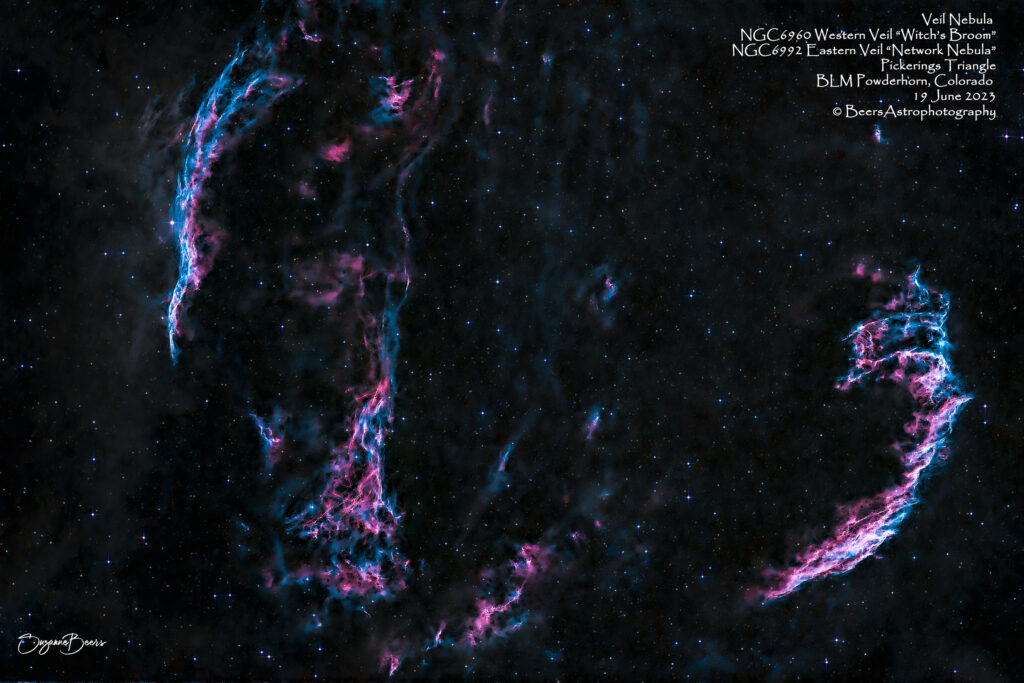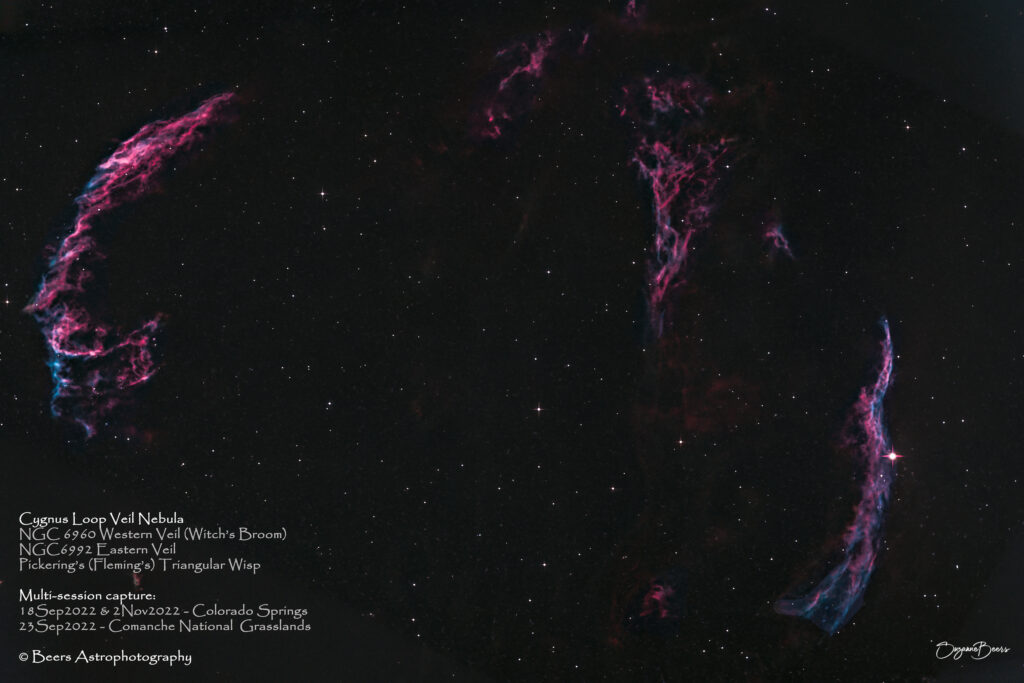
Fun facts
The Veil Nebula is a cloud of heated and ionized gas and dust in the constellation Cygnus. It constitutes the visible portions of the Cygnus Loop, a supernova remnant, many portions of which have acquired their own individual names and catalogue identifiers. The source supernova was a star 20 times more massive than the Sun which exploded between 10,000 and 20,000 years ago. At the time of explosion, the supernova would have appeared brighter than Venus in the sky, and visible in daytime. The remnants have since expanded to cover an area of the sky roughly 3 degrees in diameter (about 6 times the diameter, and 36 times the area, of the full Moon). While previous distance estimates have ranged from 1200 to 5800 light-years, a recent determination of 2400 light-years is based on direct astrometric measurements.
The Hubble Space Telescope captured several images of the nebula. The analysis of the emissions from the nebula indicates the presence of oxygen, sulfur, and hydrogen.[7] The Cygnus Loop is also a strong emitter of radio waves and x-rays.
In modern usage, the names Veil Nebula, Cirrus Nebula, and Filamentary Nebula generally refer to all the visible structure of the remnant, or even to the entire loop itself. The structure is so large that several NGC numbers were assigned to various arcs of the nebula. There are three main visual components:
• The Western Veil (also known as Caldwell 34), consisting of NGC 6960 (the “Witch’s Broom”, Lacework Nebula, “Filamentary Nebula”) near the foreground star 52 Cygni;
• The Eastern Veil (also known as Caldwell 33), whose brightest area is NGC 6992, trailing off farther south into NGC 6995 (together with NGC 6992 also known as “Network Nebula”) and IC 1340; and
• Pickering’s Triangle (or Pickering’s Triangular Wisp), brightest at the north central edge of the loop, but visible in photographs continuing toward the central area of the loop.
NGC 6974 and NGC 6979 are luminous knots in a fainter patch of nebulosity on the northern rim between NGC 6992 and Pickering’s Triangle.
Other Catalog Designations: NGC 6960, 6992, 6995, 6974, and 6979, IC 1340, Cygnus Loop, Cirrus Nebula, Filamentary Nebula, Witch’s Broom Nebula (NGC 6960), Caldwell 33/34
Subtype: Supernova Remnant
Distance from Earth: 1470 light years
Visual Magnitude: 7.0
Radius: 50 light years
Constellation: Cygnus
{From: https://en.wikipedia.org/wiki/Veil_Nebula }
Capture Notes: Dark skies trip, Powderhorn, CO (19Jun2023)
On our second night of the June 2023 dark skies trip, I’d planned to image the Blue Horsehead, then after it set either gather a bit more data on the Flying Bat at a higher gain or spend some time on Veil Nebula. It turned out that the Blue Horsehead was very low on the horizon (about 20 degrees) and was right over the top of the Beast and canopy. During the first sub-frame the autoguider lost its guide star… taking that as a bad sign, I decided to switch to Veil. It went well except for one lost guide star that terminated the sequence at about 0240. Luckily, I woke up at about 0315 to check on things and found it parked. I got restarted for another 45 minutes before the end of the night.
Equipment
Polar alignment: QHYCCD camera (controlled by Polemaster)
Imaging stream: Askar FRA600, Canon EOS Ra with Optolong LeXtreme light pollution filter
Mount: Rainbow Astro RC-135E (controlled by iHubo)
Autoguider: Orion 60mm Multi-Use Guide Scope, Orion StarShoot AutoGuider Pro Mono Astrophotography Camera (controlled by PHD2)
All equipment controlled by HP Probook running Sequence Generator Pro v3.2.0.660.
Capture & processing notes
Sequence plan: Gain: 158, Temp: -0°C, offset=NotSet. 61x5min. Captured 19Jun2023, 2217MDT – 20Jun2023, 0406MDT. Total exposure time: 5:05hrs
Captured: 19 June 2023
Shooting location: BLM land near Powderhorn, Colorado
Processing: Stacked as three sessions in APP. Processed in LR/PS.

Capture Notes: Multi-session image (18Sep2022, 23Sep2022 & 2Nov2022)
Spent three separate sessions from mid-September through early November 2022 capturing the full Veil Nebula with the Askar FRA600. The sessions were first light with RaSC using the HEM27 (during the month of September, before its return) first at HCH (18Sep2022) and then at Wisdom Tooth Arch (23Sep2022). Then with RaSC using the new-new RC-135E at HCH (2Nov2022). The image is the combination of all those sessions, processed in early December (7-9 Dec 2022) after: 1) consultation with Ann Chavtur, starting with our conversation that started after capturing the 23 September data, that was so star-filled, I thought there might be something wrong with the new telescope; and 2) information learned (and exchanged with Ann) from the 6 Dec 2022 CSASTRO Club Astro Imaging meeting presentation by Matt Russell. Then reprocessed in mid-January 2023.
18Sep2022 Capture Notes: All the equipment for the Atacama Desert astrophotography workshop (13-20 August 2023) arrived. It took a couple of weeks, with multiple calls to iOptron Technical Support, to understand the idiosyncrasies of the HEM27. First and foremost, the comm port and control board for the mount are in the handset – that must be connected to the computer and to the HBR port on the back of the mount. The autoguider must be used because of the inherent PEC in the mount – and it also has to be connected through PHD2 to the computer and an additional connection with the ST-4 cable to the back of the mount. Finally, the mount came with an old version of firmware that had to be updated before it would track properly.
23Sep2022 Capture Notes: Arrived at Wisdom Tooth Arch and set up RaSC on HEM27, using DC power from Beast house power outlet. Polar aligned using iPolar without issue. GoTo and plate solve (using PS2) on Veil Nebula. Struggled with autoguiding calibration (errors regarding too few steps, questionable guiding), ran the PHD2 Guiding Assistant several times (recommended minimum move settings changes, applied), changed to Predictive PEC algorithm in RA. Finally got the autoguider to work, after the meridian flip (i.e., the mount will not guide when on the east side of the meridian).
Equipment
Polar alignment: QHYCCD camera (controlled by Polemaster)
Imaging stream: Askar FRA600, Canon EOS Ra with Optolong LeXtreme light pollution filter
Mount: Rainbow Astro RC-135E (controlled by iHubo)
Autoguider: Orion 60mm Multi-Use Guide Scope, Orion StarShoot AutoGuider Pro Mono Astrophotography Camera (controlled by PHD2)
All equipment controlled by HP Probook running Sequence Generator Pro v3.2.0.660.
Capture & processing notes
Sequence plan(s):
19Sep2022: (HCH, RaSC HEM27 LPro) ISO1600; 64x300sec; captured 18Sep, 2041MDT – 19Sep, 0332MDT. Total exposure time: 5:20 hrs.
23Sep2022: (Wisdom Tooth, RaSC HEM27): ISO1600; 49x300sec; captured 23Sep2022 – 1x300sec subframe taken prior to the meridian flip (unusable) @ 2044MDT; 48x300sec; captured 2232 – 0242MDT. Total exposure time: 4:05 hrs.
2Nov2022: (HCH, RaSC RC135E LeX): ISO3200. 29x300sec; captured 2Nov 1931 – 2203 MDT; Total=2:25hrs.
Total integration time: 142x300sec; Total time = 11:50 hours (Consisting of ISO1600, 113x300sec; Time=9:25hours with L-Pro and no LP filter. ISO3200, 29x300sec; Time=2:25 hours with LeX filter)
Shooting location: HCH, Colorado Springs, Colorado and Wisdom Tooth Arch, Comanche National Grasslands, Colorado
Processing: Stacked as three sessions in APP. Processed in LR/PS.
